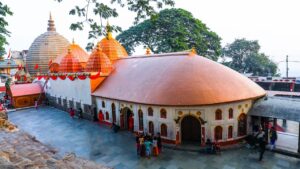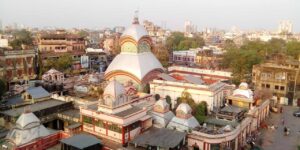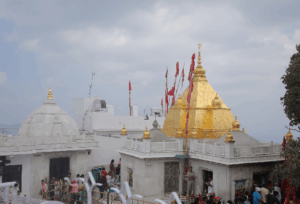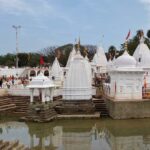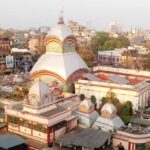Introduction
In the heart of Varanasi, India’s oldest and holiest city, lies Manikarnika Ghat—one of the most spiritually significant sites in Hinduism. Revered as a Shakti Peeth, this ghat is not just a cremation ground; it is believed to be the doorway to moksha (liberation from the cycle of rebirth). According to mythology, it is at this sacred spot that the earrings (Manikarnika) of Goddess Sati fell after her self-immolation.
🕉️ Mythological Significance
The tale of Manikarnika is deeply tied to the Shakti Peeth legend. When Goddess Sati sacrificed herself in the fire of her father’s yajna, Lord Shiva carried her burning body across the cosmos in grief. To restore balance, Lord Vishnu used his Sudarshan Chakra to cut her body into 52 parts. Her earrings (mani-karnika) fell at this ghat, making it a place charged with divine feminine energy.
Another popular legend says Lord Shiva dug a well here to find a cooling spot for his consort, and Vishnu’s chakra accidentally cut off her earrings, which fell into the well—now known as the Manikarnika Kund.
🛕 Spiritual Essence of Manikarnika Ghat
-
Manikarnika Ghat is considered the most auspicious cremation site for Hindus. It is believed that those cremated here attain instant moksha, breaking free from the cycle of birth and death.
-
Lord Shiva is believed to whisper the Taraka Mantra (the final liberation chant) into the ears of the dying at this ghat.
-
The eternal flame (Akhand Agni) at Manikarnika has been burning for centuries and is used to ignite every funeral pyre.
🔥 The Cycle of Life and Death
This ghat is unique for its deep symbolism of life, death, and rebirth:
-
The sight of constant cremations may be overwhelming, but for spiritual seekers, it’s a reminder of life’s impermanence.
-
Pilgrims come here not only to cremate their loved ones, but also to meditate on the deeper truths of existence, letting go of worldly attachments.
🙏 Rituals and Practices
-
Cremation rituals at Manikarnika follow ancient Vedic customs and are carried out by Dom Raja, a sacred undertaker caste in Varanasi.
-
Special poojas and shraddha ceremonies are performed by families for the peaceful transition of souls.
-
Many spiritual seekers and sadhus spend their final days here, desiring a holy death near the Ganges.
🧭 How to Reach
-
Location: Manikarnika Ghat, Varanasi, Uttar Pradesh
-
Nearest railway station: Varanasi Junction (about 5 km)
-
Nearest airport: Lal Bahadur Shastri International Airport (approx. 25 km)
-
Accessible by foot or boat via the ghats along the Ganges.
🏞️ Nearby Attractions
-
Kashi Vishwanath Temple – one of the 12 Jyotirlingas and just a short walk from Manikarnika.
-
Dashashwamedh Ghat – known for the famous Ganga Aarti.
-
Sankat Mochan Hanuman Temple
-
Tulsi Manas Temple
-
Gyanvapi Mosque and Well of Knowledge
✨ Conclusion
Manikarnika Ghat is a paradox—both intense and peaceful, filled with death yet charged with the hope of liberation. As a Shakti Peeth, it carries the energy of Goddess Sati, and as a cremation ground, it stands as a symbol of Shiva’s compassion to free souls from the cycle of life.
For spiritual pilgrims, mystics, and truth-seekers, this is not just a place—it is an awakening. To visit Manikarnika is to confront mortality and discover the soul’s immortality.

